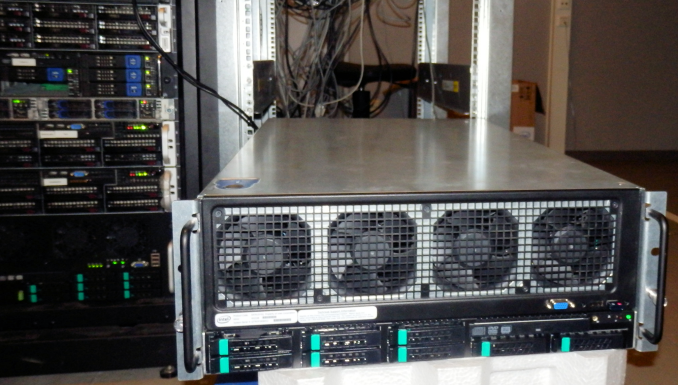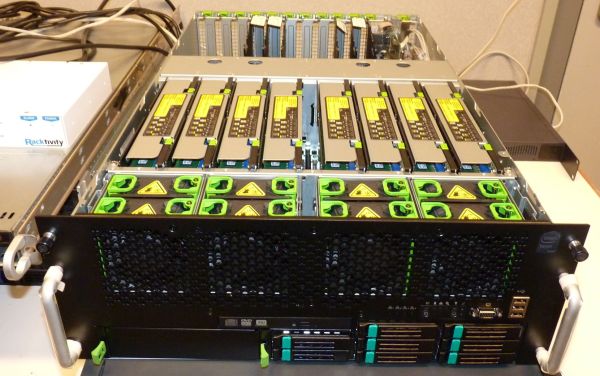The Intel Xeon E7-8800 v3 Review: The POWER8 Killer?
by Johan De Gelas on May 8, 2015 8:00 AM EST- Posted in
- CPUs
- IT Computing
- Intel
- Xeon
- Haswell
- Enterprise
- server
- Enterprise CPUs
- POWER
- POWER8
Benchmark Configuration
As far as reliability is concerned, while we little reason to doubt that the quad Xeon OEM systems out there are the pinnacle of reliability, our initial experience with Xeon E7 v3 has not been as rosy. Our updated and upgraded Quad Xeon Brickland system was only finally stable after many firmware updates, with its issues sorted out just a few hours before the launch of the Xeon E7 v3. Unfortunately this means our time testing the stable Xeon E7 v3 was a bit more limited than we would have liked.
Meanwhile to make the comparison more interesting, we decided to include both the Quad Xeon "Westmere-EX" as well as the "Nehalem-EX". Remember these heavy duty, high RAS servers continue to be used for much longer in the data center than their dual socket counterparts, 5 years or more are no exception. Of course, the comparison would not be complete without the latest dual Xeon 2699 v3 server.
All testing has been done on 64 bit Ubuntu Linux 14.04 (kernel 3.13.0-51, gcc version 4.8.2).
Intel S4TR1SY3Q "Brickland" IVT-EX 4U-server
The latest and greatest from Intel consists of the following components:
| CPU | 4x Xeon E7-8890v3 2.5 GHz 18c, 45 MB L3, 165W TDP or 4x Xeon E7-4890 v2 (D1 stepping) 2.8GHz 15 cores, 37.5MB L3, 155W TDP |
| RAM | 256 GB, 32x 8 GB Micron DDR-4-2100 at 1600MHz or 256 GB, 32x8GB Samsung 8GB DDR3 M393B1K70DH0-YK0 at 1333MHz |
| Motherboard | Intel CRB Baseboard "Thunder Ridge" |
| Chipset | Intel C602J |
| PSU | 2x1200W (2+0) |
Total amount of DIMM slots is 96. When using 64GB LRDIMMs, this server can offer up to 6TB of RAM.
If only two cores are active, the 8890 can boost the clockspeed to 3.3 GHz (AVX code: 3.2 GHz). The 4890v2 reaches 3.4 GHz in that situation. Even with all cores active, 2.9 GHz is possible (AVX code: 2.6 GHz).
Intel Quanta QSCC-4R Benchmark Configuration
The previous quad Xeon E7 server, as reviewed here.
| CPU | 4x Xeon X7560 at 2.26GHz, or 4x Xeon E7-4870 at 2.4GHz |
| RAM | 16x8GB Samsung 8GB DDR3 M393B1K70DH0-YK0 at 1066MHz |
| Motherboard | QCI QSSC-S4R 31S4RMB00B0 |
| Chipset | Intel 7500 |
| BIOS version | QSSC-S4R.QCI.01.00.S012,031420111618 |
| PSU | 4x850W Delta DPS-850FB A S3F E62433-004 850W |
The server can accept up to 64 32GB Load Reduced DIMMs (LR-DIMMs) or 2TB.
Intel's Xeon E5 Server – "Wildcat Pass" (2U Chassis)
Finally, we have our Xeon E5 v3 server:
| CPU | Two Intel Xeon processor E5-2699 v3 (2.3GHz, 18c, 45MB L3, 145W) |
| RAM | 128GB (8x16GB) Samsung M393A2G40DB0 (RDIMM) |
| Internal Disks | 2x Intel MLC SSD710 200GB |
| Motherboard | Intel Server Board Wilcat pass |
| Chipset | Intel Wellsburg B0 |
| BIOS version | August the 9th, 2014 |
| PSU | Delta Electronics 750W DPS-750XB A (80+ Platinum) |
Every server was outfitted with two 200 GB S3700 SSDs.












146 Comments
View All Comments
PowerTrumps - Saturday, May 9, 2015 - link
Ok, yes a data center like Verizon or ATT might not "qualify" but the point is accurate. I work with IBM's Power servers and have absolutely consolidated 5 racks of x86 into a single Power server - it was 54 Intel 2S & 4S servers into a single 64c Power7. Part of this is due to the "performance" of Power but most of the credit goes to the efficiency of the Power Hypervisor. PHYP can provide a QoS to each workload while weaving a greater amount of workloads onto fewer Power servers/cores than what the benchmarks imply.newtrekemotion - Friday, May 8, 2015 - link
I wouldn't discount Oracle so quickly. The T5 was a pretty big step forward from the T4 and the new M7 chip sounds like it could be quite the competitor with 2 TB of memory per socket and 32 cores, especially for highly threaded loads since an octo-socket system would have 2048 threads and support 16 TB of memory.. Hopefully this can bring some more competition to the market, though with only Oracle and Fujistu (maybe?) selling systems it won't have quite the impact that multiple POWER8 vendors could bring. Love them, hate them, or anywhere in between it seems Oracle is not ready to give up in this arena and it looks like they are putting more effort in than Sun was (or are at least executing on effort more than Sun did).Something else to note here is the process advantage that Intel has over everyone else. I might have missed it in the article, but especially for performance/watt this is important.
In all I think the statement at the beginning of the article that this area is getting more exciting is very true. Just seems like it might be a 3 way race instead of a 2. The recent AMD announcement that they wanted to focus on HPC is interesting too though of the 4 (Intel, IBM, Oracle and AMD) they have the furthest to go and the fewest resources to do it with. The next few years are going to be very interesting and hopefully someone, or a combination can push Intel and drive the whole market forward.
JohanAnandtech - Friday, May 8, 2015 - link
I was writing from a "who will be able to convert Intel Xeon people" point of view. As I wrote in the Xeon E7v2 article, Oracle's T processors have indeed vastly improved. That is all nice and well but there is no reason why someone considering a Xeon E7 would switch. Oracle's sales seems to mostly about people who are long time Oracle users. As far as I can see, OpenPOWER servers are the only real thread to Intel's server hegemony.Kevin G - Saturday, May 9, 2015 - link
Oracle does offer one reason to switch to SPARC: massive licensing discounts on Oracle software.If you're not using Oracle's software, then yeah, the SPARC platform is a very tough sell over x86 or POWER.
JohanAnandtech - Saturday, May 9, 2015 - link
exactly. Good point.PowerTrumps - Saturday, May 9, 2015 - link
If you are running Oracle software you should know that IBM and Power are the largest platform which Oracle software runs on. Secondly, if running Oracle products licensed by the core, the only platform to control Oracle licensing is Power (not including Mainframe in this assertion). I have reduce Oracle licensing for customers anywhere from 4X to 10X. Do the math on that to appreciate those savings. Lastly, when I upgrade customers from one generation to another we talk about how much Oracle they can reduce. You don't hear that when upgrading from Sandy Bridge to Ivy Bridge to Haswell.kgardas - Friday, May 8, 2015 - link
I'm not sure about T5, but certainly latest Fujitsu's SPARC64-X+ is able to over-run POWER8 and by wide margin also older Xeon's. Just look for the spec. rate. It also won some SAP S&D 2-tier benchmark on absolute performance so I'm glad that SPARC is still competitive too...Kevin G - Saturday, May 9, 2015 - link
The top SPARC benchmarks I've seen are using far more sockets, cores, threads and memory to get to that top spot. It is nice that the system can scale to such high socket counts (40) but only if you can actually fund a project that needs that absolute performance. Drop down to 16 socket where you can get twice the performance from POWER than SPARC with the same licensing cost, what advantage does SPARC have to make people switch?Even then, a system like SGI's UV2000 would fall into the same niche due to its ability to scale to insane socket counts, software licensing fees be damned.
kgardas - Tuesday, May 12, 2015 - link
Kevin G, actually you are right and I made an mistake. It was not intentional, I was misled by spec site claiming "24 cores, 4 chips, 6 cores/chip, 8 threads/core" for "IBM Power S824 (3.5 GHz, 24 core, RHEL)" so I've thought this is 4 socket setup and I compared it with Fujitsu M10-4 which won. Now, I've just found IBM is two socket which means it wins on socket/spec rate basis of course. Price-wise IBM is also way much cheaper than SPARC (if you don't run Oracle DB of course) so I keep my fingers crossed for OpenPOWER.Honestly, although this is really nice to see I still have kind of feeling that this is IBM hardware division swan's song. I would really like to be wrong here. Anyway, I still think that ARMv8 does have higher chances in getting into the Intel's business and be really a pain for Intel. On the other hand if OpenPOWER is successful in Chinese business, that would be good and some chance for us too to see lower-cost POWER machines...
PowerTrumps - Saturday, May 9, 2015 - link
yes, take a look at those benchmark results and you see the Fuji M10-4S requires 640 & 512 cores. Even the Oracle M6-32 uses 384 cores. The Fuji 512c example had 33% higher SAPS with 2X the cores. The M6-32 has 50% more cores to get 21% higher SAPS. Further, looking at the SAP benchmark as a indicator of core, chip & server performance shows that SPARC & Intel are roughly 1600 - 2200 SAPS per core compared to Power8 which is 5451 SAPS for the 80 core E870. So you put this into context the 80 core Power8 has slightly less than 1/2 the SAPS of the 640 core Fujitsu M10-4S. Think of ALL the costs associated with 640 cores vs 80...ok, 160 if we want to get the SAPS roughly equal. 4X more cores to get less than 2X the results.